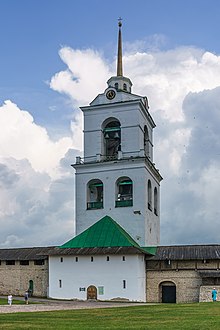Pskov Kremlin
The Pskov Kremlin ( Russian Псковский Кремль ) or Pskower Krom ( Псковский кром ) is a former citadel in the Russian city of Pskov . The approximately three hectare ensemble of a historical fortification wall and several sacred and secular buildings forms the Pskov city center and is located on a hill at the confluence of the Pskowa River into the Velikaya .
history
The exact date of origin of the Pskov Citadel is not known, but it is likely to be one of the oldest Russian fortresses. As early as the 12th century, Pskov served as a border fortress of the then Novgorod Republic and had its own fortifications. So the Pskov Kremlin must have been built earlier than its Moscow counterpart, for example . The first fortifications were made of wood, a stone protective wall was built around the beginning of the 12th century. As was customary in all Russian principalities of the Middle Ages, a Kremlin always served as the center of the city's social and economic life; the Pskov Kremlin was no exception in this regard.
At the end of the 13th century, the Pskov fortress was expanded to include the section known today as Daumantas City ( Довмонтов город ). The name was derived from the name of the Lithuanian prince Daumantas , who was Pskov prince from 1266 to 1299. This new part of the fortress was also built of stone. However, nothing of the original structures of the 12th and 13th centuries has survived to this day, as both the walls of the Pskov Kremlin and the structures within them have been destroyed and rebuilt and rebuilt several times over the centuries.
The Pskov Citadel was most important in the 14th and 15th centuries, when the city of Pskow existed as an independent republic . The Trinity Cathedral, which already stood within the Kremlin walls at that time, served as the main church of the state, and the Kremlin grounds also housed extensive stores for provisions, weapons and treasures. In 1510 the Pskov state became part of the Grand Duchy of Moscow ; At that time, the Kremlin treasures were robbed and the Kremlin itself lost its importance as a fortress and city center.
In the course of the next two centuries, the former fortress fell into disrepair; only in the years 1682–1699 was the Trinity Cathedral rebuilt. At the beginning of the 18th century, during the reign of Peter I , the Pskov Kremlin regained importance as a citadel for a short time: In the event of possible attacks in the Great Northern War , Peter had the walls fortified again, for which several church buildings had to be removed.
In the middle of the 19th century, the former Kremlin walls with watchtowers were rebuilt under the direction of the famous city architect Konstantin Thon . The ensemble has served as a museum complex since the 1960s and is being intensively researched through archaeological excavations, and the structures that have been preserved are also being restored.
Buildings
The fortifications of the Pskov Kremlin, which have survived to this day, consist of a stone wall almost 900 meters long with three sections (the western, the eastern and the southern) with seven watchtowers, one of which - the so-called Daumantas Tower - was only built in the 1860s Years ago for decorative purposes. A special feature that did not exist in other Russian Kremlins is a former Sachab (Russian захаб ), d. H. a narrow corridor inside the fortress, which could be used as a kind of trap for possible attackers and thus also served as part of the protective systems.
Inside the Kremlin, the Trinity Cathedral ( Троицкий собор ) is the most important building that has survived to this day. It has been the Pskov Episcopal Church since 1589 . In its current form, it was built in the years 1682–1699 and replaced the cathedral of the same name from 1367, which in turn had two previous buildings (one made of stone and one made of wood). Next to the Trinity Cathedral is the bell tower, which was only built in the 1830s.
The section of the Pskov Kremlin known as Daumantas City ( Довмонтов город ) has been preserved in parts . In the second half of the 20th century it was examined in great detail by excavations, as this part was much more densely built up than the old Kremlin section. Of the up to 12 church buildings in the Daumantas city, not a single one has survived today; only the Prikas buildings from the years 1693–1695 are still standing. They are considered an important monument of the secular architecture of the 17th century.
See also
literature
- Галина Вацлавна Длужневская, Владимир Александрович Калинин, Андрей Викторович Сужневская, Кремсандрович Калинин, Андрей Викторович Сукторович Субибовин : XV - XVII. Литера, Санкт-Петербург 2006, ISBN 5-94455-523-8 , pp. 122–126
Web links
- Culture.pskov.ru: Pskov Kremlin (Russian, photos)
- Pskovcity.ru: Pskov Krom (Russian)
Coordinates: 57 ° 49 ′ 17 ″ N , 28 ° 19 ′ 46 ″ E


